Amaranthus tuberculatus
Overview
Aperçu
Regulation :
Remarques Réglementation:
- CFIA Weed Seeds Order - Class 2: Primary Noxious Weed Seeds
Regulation Notes:
Distribution :
Répartition :
Native to eastern North America (USDA-ARS 2022) and introduced into Asia (Israel and Jordan), the western United States and Europe (CABI 2022). In Canada, this species occurs in Manitoba, Ontario and Quebec provinces (Darbyshire 2003; Brouillet et al. 2010+). Some authors have divided this species into two varieties Amaranthus tuberculatus (Moq.) Sauer var. tuberculatus, which is native to the three provinces mentioned above, and A. tuberculatus (Moq.) Sauer var. rudis (Sauer) Costea & Tardif, which is an introduced variety found only in Ontario (Costea et al. 2005; Brouillet et al. 2010+).
Habitat and Crop Association :
Habitat et Cultures Associées :
This species prefers well-drained and nutrient rich soils along the edges of rivers, lakes, ponds and ditches, and disturbed areas in cultivated fields, roadsides and gardens (FNA 1993+; Darbyshire 2003; Costea et al. 2005 ). This species can be a dominant weed in Glycine max (L.) Merr. (soybean) fields in Canada and the United States, and Zea mays L. subsp. mays (corn) fields in the United States (Costea et al. 2005).
Economic Use, cultivation area, and Weed Association :
Utilisation économique, zone de culture et association de mauvaises herbes :
Duration of Life Cycle :
Durée du cycle vital:
Annual
Dispersal Unit Type :
Type d’unité de dispersion :
Seed
General Information
RENSEIGNEMENTS GÉNÉRAUX
Amaranthus tuberculatus plants have been estimated to produce 35,000-1,200,000 seeds per plant and can form persistent seed banks under cultivation (Costea et al. 2005). Both seeds and fruits float and the species prefers to grow near water (Costea et al. 2005), suggesting that water may be a significant dispersal method for this species.
A. tuberculatus, although native in North America, is a concerning agricultural pest due to prolific seed production and resistance to multiple types of herbicides (Patzoldt et al. 2001; CABI 2022). This resistance has developed due to the genetic diversity of a dioecious habit (obligate cross-pollination) and the intense selective pressure of herbicides. Additional factors include no-till agriculture and increase in planting monocultures of affected crops (Patzoldt et al. 2001; CABI 2022).
Authors have debated about the probability that North American A. tuberculatus is composed of two varieties. Amaranthus tuberculatus (Moq.) Sauer var. rudis (Sauer) Costea & Tardif is believed to be native in the southern United States, associated with the edges of water bodies and wet, disturbed habitats. The other variety, A. tuberculatus (Moq.) Sauer var. tuberculatus, has a more northern range, extending into southern Ontario, Manitoba and Quebec where it prefers edges of water bodies without disturbance (FNA 1993+; Costea et al. 2005; Brouillet et al. 2010+).
It has been proposed that the differences observed in habitat and utricle features may have arisen from regional phenotypes, and any differences are being erased by agricultural-related introduction of both varieties outside of original ranges (FNA 1993+; Pratt and Clark 2001).
.Identification
Identification
-
Utricle
Size
- Utricle length: 1.5 – 2 mm (FNA 1993+; Costea et al. 2005)
Shape
- Utricle is egg-shaped or almost globose (FNA 1993+)
Surface Texture
- Utricle surface is generally wrinkled when dry, some are more smooth, not ribbed (FNA 1993+; Costea et al. 2005)
Colour
- Utricle is dull brownish or reddish coloured (FNA 1993+; Costea et al. 2005)
Other Features
- Utricle can be transversely dehiscent at maturity or remain indehiscent (FNA 1993+)
- For those authors that recognize two varieties, utricles are dehiscent and shed with 1-2 tepals below the fruit in Amaranthus tuberculatus var. rudis and indehiscent with no tepals in A. tuberculatus var. tuberculatus

Tall water-hemp (Amaranthus tuberculatus); seeds and capsule

-
Seed
Size
- Seed length*: 0.8 – 1.0 mm; width: 0.7 – 0.9 mm
*Note: minimum and maximum of 10 seeds in a normal range of this species using image measurement (ISMA 2020)
Shape
- Seed is generally egg-shaped, but some seeds are round or oval shaped, a compressed lens-like shape in 3-D
Surface Texture
- Seed surface is smooth with striations at the hilum area
- A faint ridged reticulation pattern can be seen on some seeds with a magnification of at least 40x
Colour
- Seed is glossy red, reddish brown or dark brown coloured
Other Features
Hilum and hilum area
- Hilum is near one end of the seed in a notch
- Seeds may have persistent tissue at the hilum
- The hilum areas are concave, and look pinched in the edge view
- The lobes of the hilum are generally elongated and offset in edge view
Other than hilum
- The reticulate rim around the seed is generally lacking in this species, occasional seeds may have a textured rim that looks ‘frosted’

Tall water-hemp (Amaranthus tuberculatus); seeds


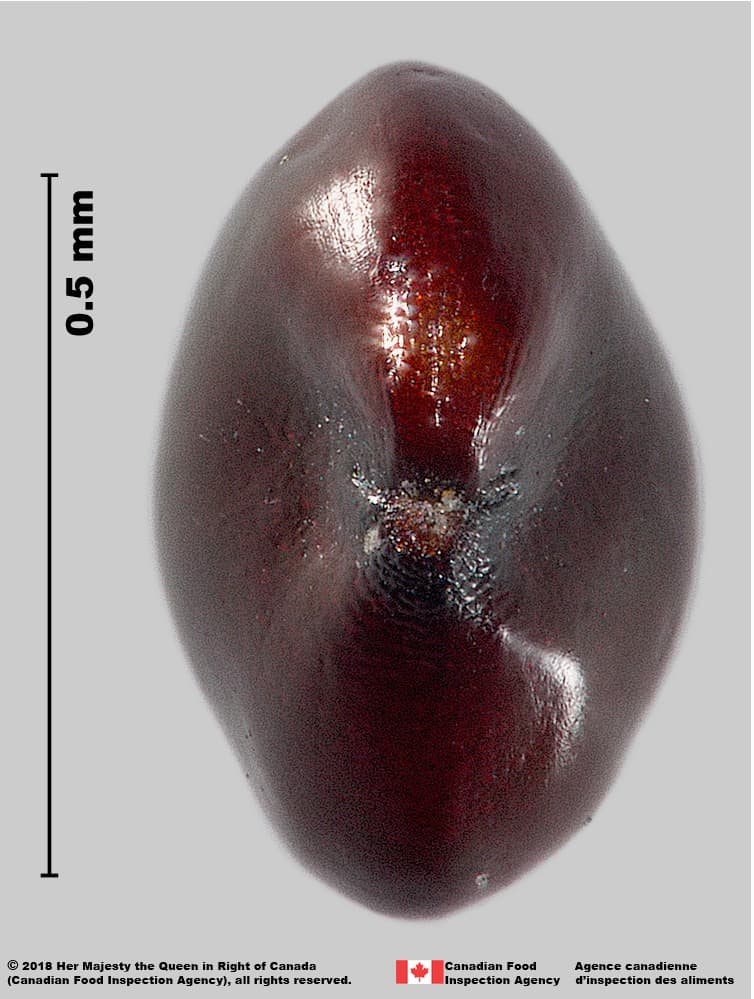
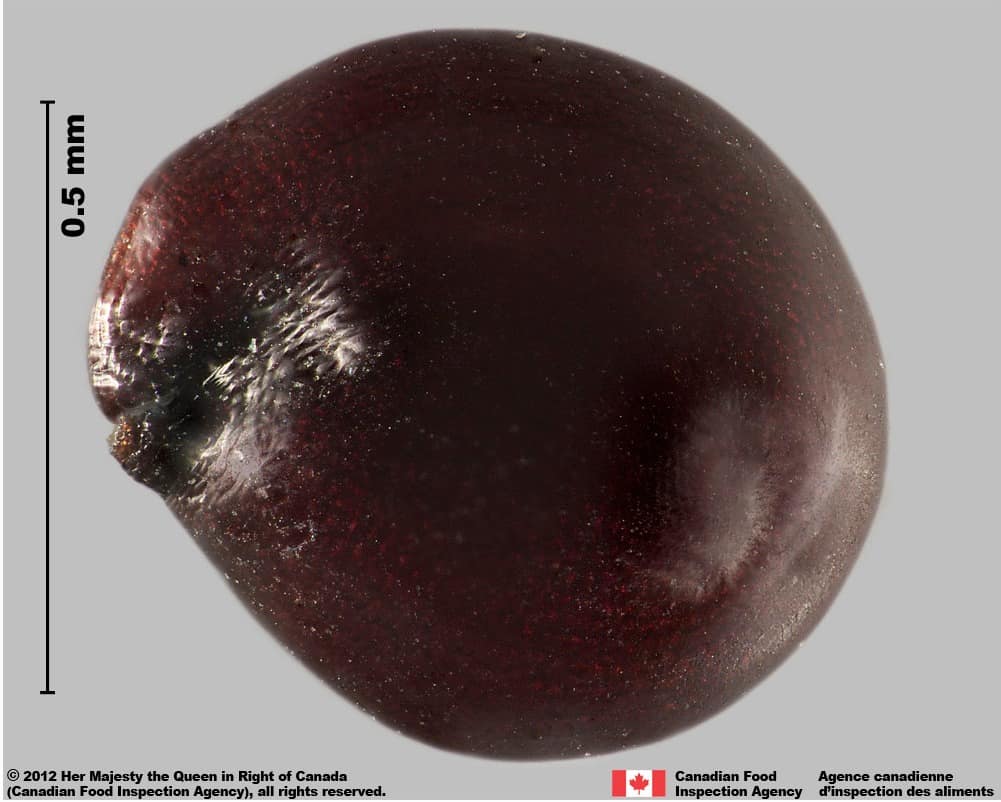

-
Embryo
Size
- Embryo partially fills the seed
Shape
- Embryo is curved (Martin 1946)
Endosperm
- Endosperm scant
Other Features
- Embryo in a peripheral position
- Perisperm copious, hard and translucent white coloured
Identification Tips
CONSEILS POUR L’IDENTIFICATION
Amaranthus tuberculatus seeds are generally equal to or smaller than 1.0 mm, a similar size as A. albus, A. virdis, A. spinosus and A. fimbriatus seeds. A. tuberculatus seeds can be distinguished from these similar species by a combination of a smooth surface, reddish-brown colour, lack of a defined rim, and a concave hilum area with protruding hilum lobes. The fruits of this species can be indehiscent or dehiscent and the plants are dioecious.

Tall water-hemp (Amaranthus tuberculatus); seed




Additional Botany Information
AUTRES RENSEIGNEMENTS BOTANIQUES
Flowers/Inflorescence
- Amaranthus tuberculatus is a dioecious species, with the male and female flowers on separate plants (FNA 1993+; Costea et al. 2005 )
- Flower clusters are subtended by bracts 1.5 – 2.5 mm long and concentrated into flowering branches 10-20 cm long (Costea et al. 2005)
- Male flowers have 5 tepals, female flowers have 1-2 tepals, or absent (FNA 1993+)
Vegetative Features
- Leaves of the plant are generally oblong, elongated oval or egg-shaped (lanceolate), more narrow than those of Amaranthus retroflexus, A. hybridus and A. powellii (Costea et al. 2005)
- The petiole of the leaf is ¼ to ½ the blade length, shorter than A. retroflexus, A. powellii and A. palmeri, and a similar length as A. albus petiole that is up to ½ blade length (FNA 1993+)
Similar Species
ESPÈCES SEMBLABLES
Similar species are based on a study of seed morphology of various species, and those with similar dispersal units are identified. The study is limited by physical specimen and literature availability at the time of examination, and possibly impacted by the subjectivity of the authors based on their knowledge and experience. Providing similar species information for seed identification is to make users aware of similarities that could possibly result in misidentification.
Amaranthus retroflexus L.
A. retroflexus is a common, worldwide weed that can be found in many soil types and habitats (FNA 1993+). The seed is generally larger (length*: 0.7 – 1.2 mm; width: 0.7 – 1.1 mm) than A. tuberculatus, with grooved reticulation around the outside of the seed, and is black- coloured with a silvery reticulation pattern. A. tuberculatus seeds generally do not have a textured rim and are reddish-brown coloured.
*Note: minimum and maximum of 10 seeds in a normal range of this species using image measurement (ISMA 2020)
Amaranthus albus L.
A. albus is a common, widespread weed of sandy, disturbed habitats in the United States and Canada (FNA 1993+; Darbyshire 2003,). The seeds are a similar size as A. tuberculatus seeds. The hilum area of A. albus may be slightly concave, but the hilum lobes do not protrude as in A. tuberculatus. The seeds are inflated in edge view compared to A. tuberculatus, with faint grooved reticulation on the rim around the outside of the seed.
Amaranthus viridis L.
A. viridis is native to South America, and now widespread in tropical, subtropical and warm-temperate regions (FNA 1993+; USDA-ARS 2022). It is found in the southern and eastern United States, and has been found occasionally in Quebec province (FNA 1993+; Brouillet et al. 2010+). The seeds are a similar size as A. tuberculatus (1 mm diameter, FNA 1993+), but are generally round, black coloured with a generally rough surface, small hilum lobes and an indehiscent utricle, compared to the egg shape, red colour, smooth surface, protruding hilum lobes and a dehiscent or indehiscent utricle of A. tuberculatus.
Amaranthus spinosus L.
A. spinosus is native to tropical America, and has spread to disturbed habitats in tropical and some warm-temperate areas worldwide (FNA 1993+). It is found in the eastern half of the United States and California, and Quebec and Manitoba provinces in Canada (FNA 1993+; Brouillet et al. 2010+). Seeds are a similar size as A. tuberculatus (0.7 – 1 mm diameter, FNA 1993+), but are round with small hilum lobes and a thick or inflated utricle, compared to the egg shape, protruding hilum lobes and thinner utricle of A. tuberculatus.
Click to select species
Cliquez pour sélectionner les espèces

Amaranthus retroflexus
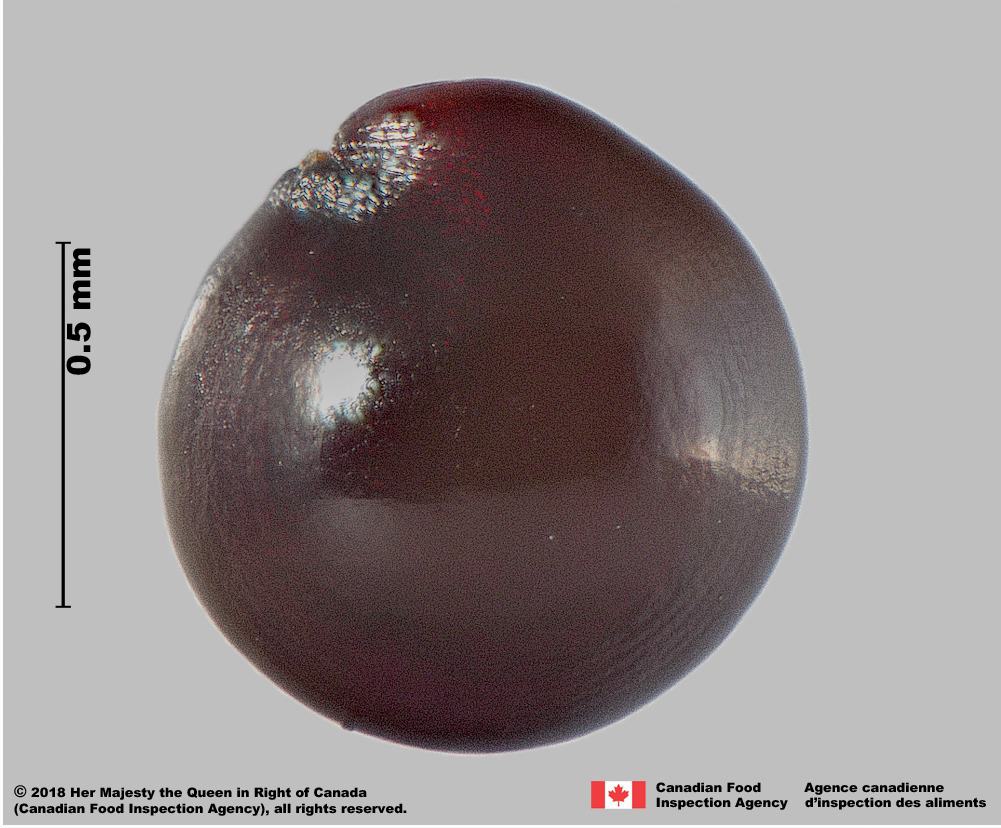
Amaranthus albus

Amaranthus viridis
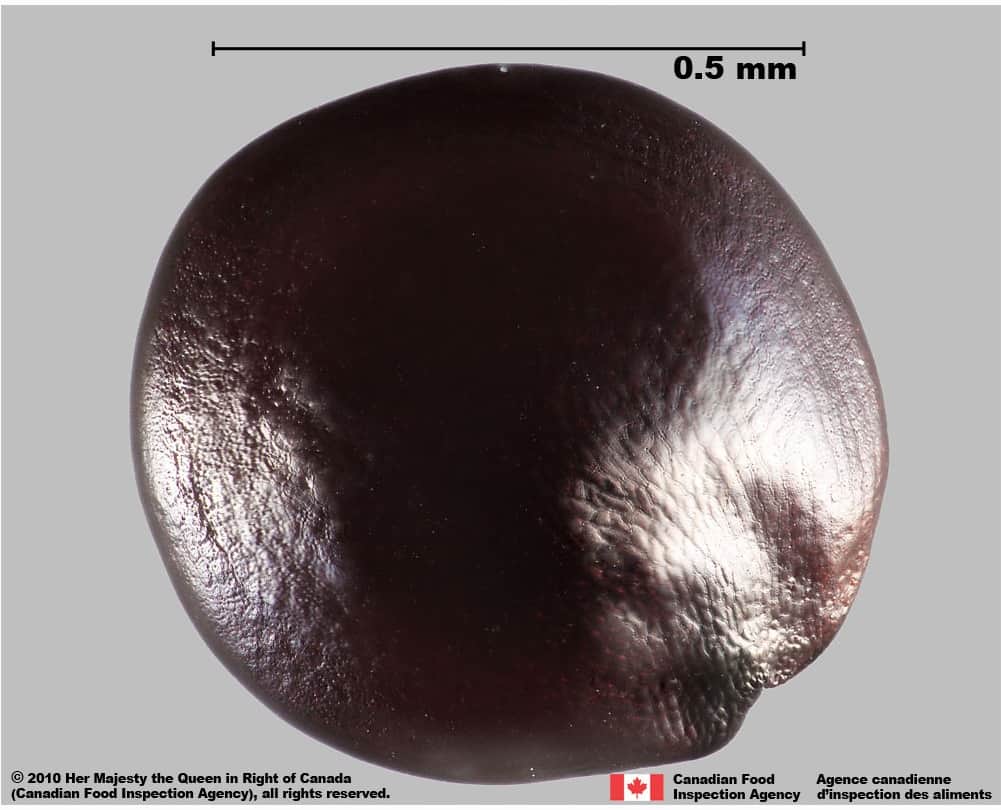
Amaranthus spinosus
Comparison Window
Fenêtre de comparaison
MAIN SPECIES
ESPÈCES PRINCIPALES
Amaranthus tuberculatus

Amaranthus tuberculatus
Amaranthaceae
Tall water-hemp (Amaranthus tuberculatus); seeds
MAIN SPECIES
ESPÈCES PRINCIPALES
Amaranthus tuberculatus

Amaranthus tuberculatus
Amaranthaceae
Tall water-hemp (Amaranthus tuberculatus); seed
MAIN SPECIES
ESPÈCES PRINCIPALES
Amaranthus tuberculatus

Amaranthus tuberculatus
Amaranthaceae
Tall water-hemp (Amaranthus tuberculatus) seed; hilum view
MAIN SPECIES
ESPÈCES PRINCIPALES
Amaranthus tuberculatus

Amaranthus tuberculatus
Amaranthaceae
Tall water-hemp (Amaranthus tuberculatus); seed
MAIN SPECIES
ESPÈCES PRINCIPALES
Amaranthus tuberculatus

Amaranthus tuberculatus
Amaranthaceae
Tall water-hemp (Amaranthus tuberculatus) seed; hilum view
MAIN SPECIES
ESPÈCES PRINCIPALES
Amaranthus tuberculatus

Amaranthus tuberculatus
Amaranthaceae
Tall water-hemp (Amaranthus tuberculatus); seeds and capsule
SIMILAR SPECIES
ESPÈCES SEMBLABLES
Amaranthus retroflexus

Amaranthus retroflexus
Amaranthaceae
Red-root pigweed (Amaranthus retroflexus) seeds
SIMILAR SPECIES
ESPÈCES SEMBLABLES
Amaranthus retroflexus

Amaranthus retroflexus
Amaranthaceae
Red-root pigweed (Amaranthus retroflexus) seed
SIMILAR SPECIES
ESPÈCES SEMBLABLES
Amaranthus retroflexus

Amaranthus retroflexus
Amaranthaceae
Red-root pigweed (Amaranthus retroflexus) seeds and capsule
SIMILAR SPECIES
ESPÈCES SEMBLABLES
Amaranthus retroflexus
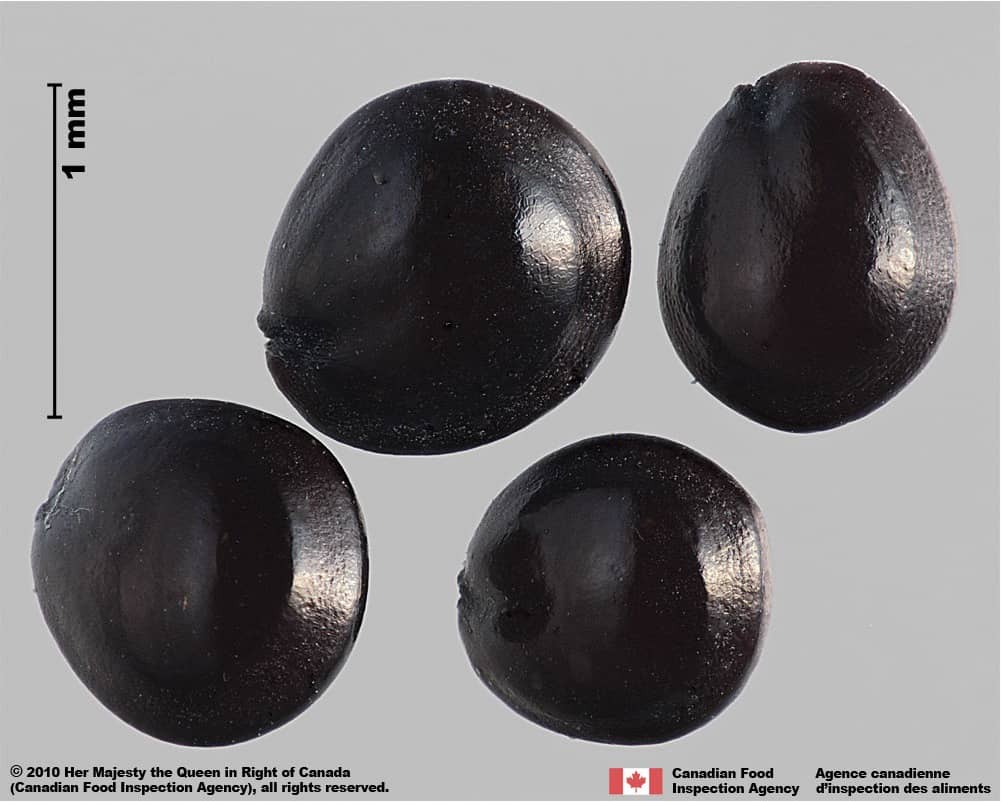
Amaranthus retroflexus
Amaranthaceae
Red-root pigweed (Amaranthus retroflexus) seeds
Need ID Help?
Besoin d’aide pour l’identification?
Reference(s)
Référence(s)
Brouillet, L., Coursol, F., Meades, S. J., Favreau, M., Anions, M., Bélisle, P. and Desmet, P. 2010+. VASCAN, the database of vascular plants of Canada. http://data.canadensys.net/vascan/ Accessed March 03, 2022.
Centre for Agriculture and Bioscience International (CABI). 2022. Invasive Species Compendium, CAB International, Wallingford, UK. https://www.cabidigitallibrary.org/journal/cabicompendium Accessed March 03, 2022.
Costea, M., Weaver, S. E. and Tardif, F. J. 2005. The Biology of Invasive Alien Plants in Canada. 3. Amaranthus tuberculatus (Moq.) Sauer var. rudis (Sauer) Costea & Tardif. Canadian Journal of Plant Science 85: 507-522
Darbyshire, S. J. 2003. Inventory of Canadian Agricultural Weeds. Agriculture and Agri-Food Canada, Research Branch. Ottawa, ON.
The Flora of North America Association (FNA). 1993+. Flora of North America North of Mexico. 19+ vols. Flora of North America Editorial Committee, eds. New York and Oxford, http://beta.floranorthamerica.org/Main_Pagehttp://www.fna.org/FNA/ Accessed March 03, 2022
Government of Canada (GC). 2016. Canadian Weed Seeds Order. https://laws-lois.justice.gc.ca/eng/regulations/SOR-2016-93/page-2.html (English) https://laws-lois.justice.gc.ca/fra/reglements/DORS-2016-93/page-2.html (French)
International Seed Morphology Association (ISMA). 2020. Method for Seed Size Measurement. Version 1.0. ISMA Publication Guide.
Martin, A.C. 1946. The comparative internal morphology of seeds. The American Midland Naturalist 36: 513-660.
Patzoldt, W.L., Tranel, P.J. and Hager, A.G. 2001. Variable herbicide responses among Illinois waterhemp (Amaranthus rudis and A. tuberculatus) populations. Crop Protection 21:707-712.
Plants of the World Online (POWO). 2022. Facilitated by the Royal Botanic Gardens, Kew. Published on the Internet; http://www.plantsoftheworldonline.org/ Accessed April 29, 2022.
Pratt, D.B. and Clark, L.G. 2001. Amaranthus rudis and A. tuberculatus-one species or two? Journal of the Torrey Botanical Society 128: 282-296
Tropicos. 2022. Missouri Botanical Garden. https://tropicos.org Accessed April 29, 2022.
U.S. Department of Agriculture-Agricultural Research Services (USDA-ARS). 2022. Germplasm Resources Information Network (GRIN), https://npgsweb.ars-grin.gov/gringlobal/taxon/taxonomysimple.aspx Accessed March 03, 2022.




